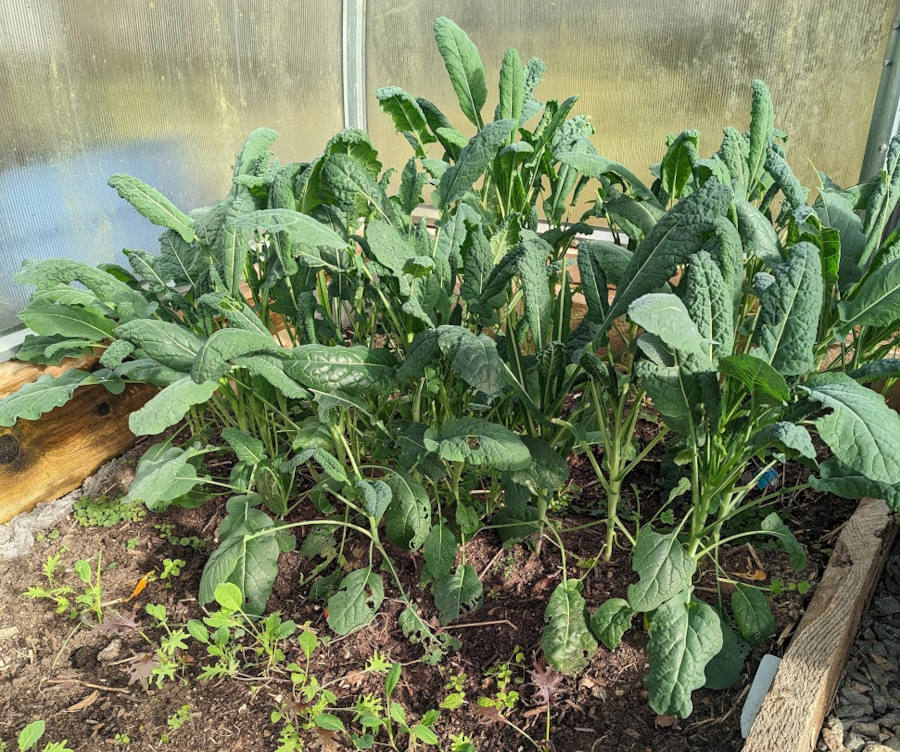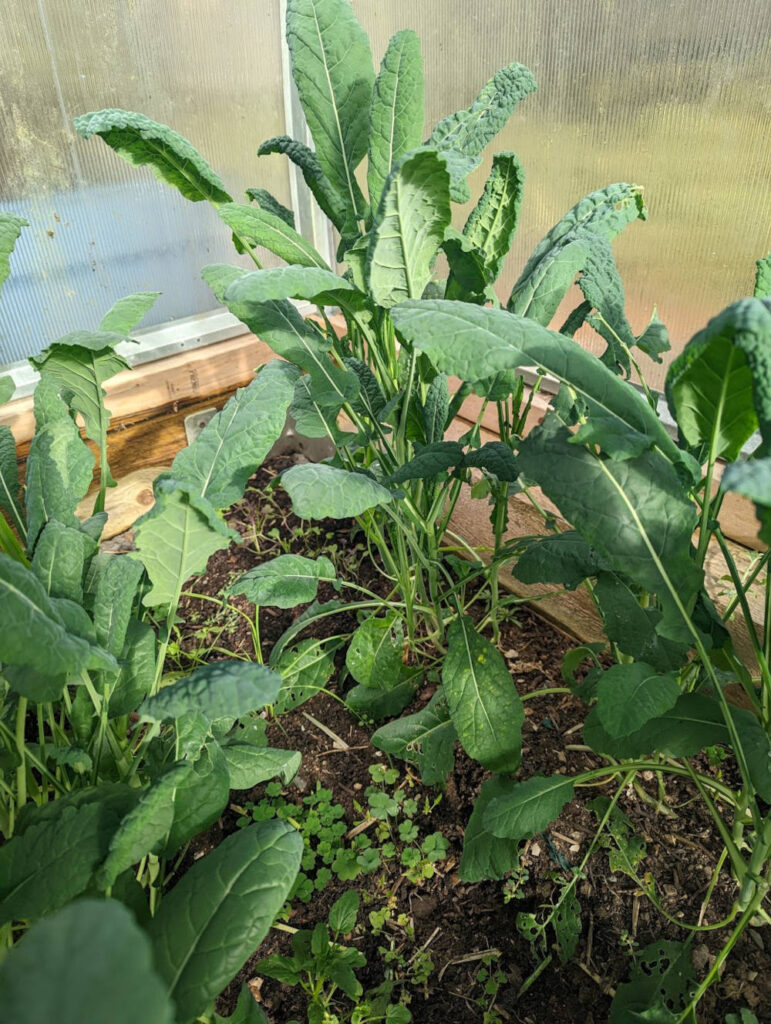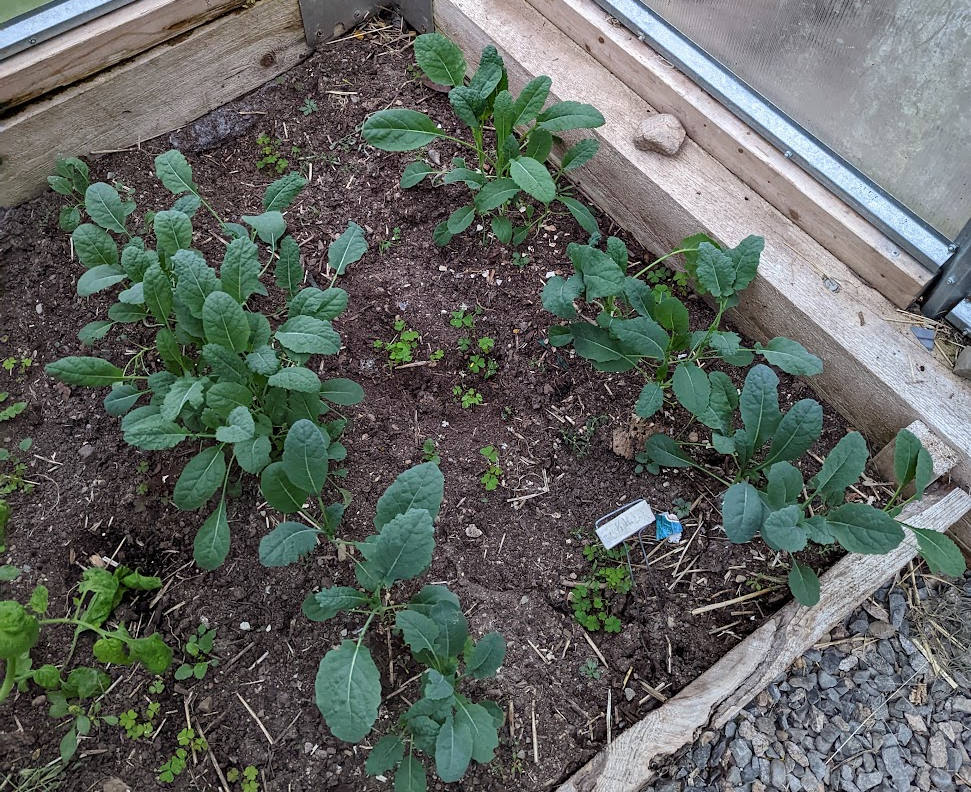For a crop that’s truly “head” and shoulders above the rest, the wise gardener knows exactly when to harvest kale. Easily grown from seed, it is best to start in the late winter and into the early spring (depending if you’re starting seedlings indoors), then again toward the close of summer. If you plant accordingly and harvest at just the right time, you can look forward to enjoying fresh, delicious kale longer throughout the year.
What Is Kale?
Kale is a loose-leaf garden green often lumped in with cooking greens like, collards, mustard, and Swiss chard. Its “head” is not tight and compact like some lettuces and cabbage. Brassica oleracea is a quick growing crop. It comes in a wide variety of shapes, colors, and sizes. It even brings an aesthetic bonus to your garden plot, with some varieties offering intricately curled leaves and ruddy to purpling tips. No matter the color, most kale species can grow to harvest from seed in just around ninety days.
Kale is considered a biennial plant. This means that even though it is ripe for harvest within its first year of growth, it won’t complete its life cycle until well into its second year. The edible leaves coveted by gardeners will be ready in as little as 60 days if planted from seedlings and closer to three months from seed. But regardless of how you start your kale plants, you won’t see flowers and seeds until the plant is into its second year.
What Can You Do with Kale?

Kale is an incredibly versatile addition to your vegetable garden. It lends itself as a vitamin and mineral-enriched base for delicious salads. It can help a delicious smoothie pack an extra nutritious punch. It can also curb those crunchy snack craving when prepped as crispy kale chips.
When you’re considering which variety or varieties you’re going to cultivate, there are many things to keep in consideration. If you want a hardy plant that will weather colder temperatures longer and extend your harvest season, consider the curly-leafed kale. If you just can’t wait to savor a bright kale salad, however, flat-leaf greens get the go light faster.
In fact, if you like your salads with a sweet side, Red Russian kale is a colorful, flat-leaf variety that will not only bring hues of violet to your garden but is also one of the sweetest cultivars. You can also grow Hanover Salad, which is an expedient grower and lends a delightful taste to any salad.
For variants that stand up to harsher temperatures, you might want to consider the thick, leafy “dinosaur” kale, or cavolo negro. This type of kale, which bears a slightly sweet, nutty taste, is popular in a wide variety of Italian dishes. And Vates kale, a dwarf variety that can do well in container gardening, is not only cold and heat tolerant, it also crisps up nicely for a go-to, vitamin rich crunchy snack! But when all is said and done, to cultivate a truly bumper crop, you need to know the best time to harvest this nutritional powerhouse.
When to Harvest Kale
For as many cultivars of kale that exist, there are as many different optimum times on when to harvest kale. If you’re planting from seed, the first thing you need to do is note the expected maturity date indicated on the packet. Different varieties mature sooner than others. From there, it’s a matter of deciding how you want to enjoy the fruits, er, veggies of your labor.
Harvesting Baby Kale

If Elvis was a baby kale salad, he would probably croon “Love Me Tender.” That’s exactly what a salad made of young kale leaves is—the familiar kale punch with a tender, more delicate bite you’ll love.
More people favor baby kale leaves for use in raw recipes like salads and with good reason. The younger leaves don’t overpower the other ingredients in a dish like more mature leaves can. They also aren’t as tough as a more mature kale leaf can be. They rarely require extra effort in preparation such as massaging. Massaging is a process which uses oil and lemon juice to break down the tough, fibrous tissue of the kale to make it more tender. But before you can enjoy your baby kale in your favorite dish, you need to harvest it.
The best time to begin harvesting baby kale leaves ranges from approximately 25 to 30 days after planting. To avoid small yields, don’t start harvesting until your plants sport several sets of 2-3-inch leaves. If you know you’re cultivating a quick-growing variety of kale, keep a sharp eye on your plants even before the 30-day mark hits. It doesn’t take very long for kale plants to mature beyond the tender, baby stage.
If your menu regularly includes baby kale plan ahead, and plant accordingly. Also, if your menu also requires full-grown kale, keep in mind that copious harvesting at the baby stage will delay the development of mature leaves.
Harvesting Full-Grown Kale
The fully mature kale leaf has a more pungent flavor than baby kale. They are also more fibrous, making them tougher in texture. Many cooks prefer to use a technique like massaging to tenderize their kale, but many others just go ahead and use the mature kale as is without additional treatment. Either way, full-size kale is delicious no matter how you serve it but should be eaten before the leaves start to brown or yellow.

On average, most varieties of kale will mature around sixty days after they are planted. If you’ve begun your kale from seeds, allow as much as ninety days for your plants to grow to maturity. Look for leaves that are about the size of your hand, give or take. Remember that kale leaves will toughen as they get bigger. If you harvest leaves larger than your hand, be prepared to use them in cooked dishes or dehydrate them for some tasty kale chips.
Factoring in the Weather When Harvesting
When the temperatures start dipping, gardeners with crops other than kale rush to pick that last harvest. Savvy kale growers know, however, that a mild frost or two is actually beneficial to the kale’s flavor. The cold forces the plant to converts starch into sugar, a survival response that keeps the leaves from freezing. This natural occurrence is known as “cold-induced sweetening” or chill sweetening. Watch out, however. If the mercury dips below 20°F, either protect your plants or make your last harvest of the season.
While cold can have limited benefit to kales plants, heat can prove damaging to a growing crop. Excessive exposure to direct sun and withering summer heat can make plants fade and encourage a bitter, unwanted taste. Harvesting a crop before the temperature climb can circumvent this. Alternatively, you can provide shade protection to a crop that might not quite be ready for harvesting.
Harvesting Kale Seeds
You’ve harvested your baby kale. You’ve cooked up your mature kale into a scrumptious zuppa Toscana. But the harvest isn’t done yet! We’ve already mentioned that kale is a biennial plant, producing leaves in its first year. But to sustain your crop beyond the next growing season, you can harvest the seeds your kale plants will produce in their second year of growth.
After the kale has gone through a dormant cold period, like winter, it enters another stage of its life cycle. When the weather beings to warm, keep an eye on your plants and you will see them start to produce flowers then seeds. Frugal gardeners will harvest those seeds and use then to plant the next crop.
If you plan to harvest your seeds, make sure you encourage pollination with your planting process. Grouping of ten or more plants are most conducive to pollination. After the kale plants “bolt” and produce flowers, don’t uproot them even if you have completed your leaf harvest for the season. Instead, allow the seed pods to develop and brown naturally on the plant. Once they have dried out, then pick the pods from the plants.
The next step in the seed harvest is to gently rub the pods over a tray or bowl to catch the falling seeds. Since any moisture will encourage rot and decay, be sure to dry your seeds on a paper towel for at least a week. Once completely dried, they can be stored in a moisture-proof container for up to four years.

FAQS
When is the best time to harvest baby kale?
The best time to harvest baby kale depends on a variety of factors. First, be sure to check the date on the seed packet to determine when your particular cultivar reaches maturity. Then, approximately 30 days after planting, you should be able to begin harvesting 2 to 3-inch leaves. If you expect to use a lot of baby kale, plan accordingly and plant a number of plants.
When is the best time to harvest full-grown kale?
Again, best specific times to harvest full-grown kale will depend on the variety you are growing. As a general rule of thumb, you should harvest full-grown kale when you see leaves close to the size of your palm. Depending on whether you started your plants from seeds or seedlings, this can be anywhere between sixty and ninety days. Keep in mind that the older the leaves are, the tougher and more fibrous they become. Older leaves may require additional handling, such as massaging, to make them tender. Do be certain to pick leaves before they start to yellow and brown. And don’t be afraid to allow your kale plants to endure a light frost. Light frost will encourage cold-induced sweetening, making your more mature plants more palatable.
Can you only plant kale once a year?
No. Savvy kale growers take advantage of the two times a year ripe for kale planting. You can plant kale outdoors in the early spring, after the dangers of the last frost. You can also plant kale in the late summer when the harsher temperatures have passed for a fall crop.
When is the best time to harvest kale seeds?
The best time to harvest kale seeds is always in your kale plant’s second year. Kale is a biennial plant and will only produce flowers and seed pods after it has gone through a cold, dormant period. Keep in mind that kale flowers do not self-pollinate. Therefore, if your intent is to harvest seeds, ensure to plant them in groups of ten or more to encourage pollination. Once the flowers have bolted and you see seed pod begin to form, wait for them to dry out and brown on the plant before harvesting. Then you can dislodge the seeds from the pod, complete the drying process, and store in a moisture-proof, sealed container in a cool dry place so you’re ready to grow your next bumper crop.
